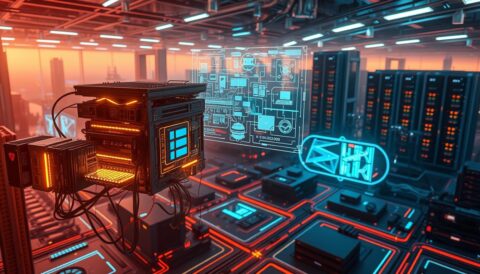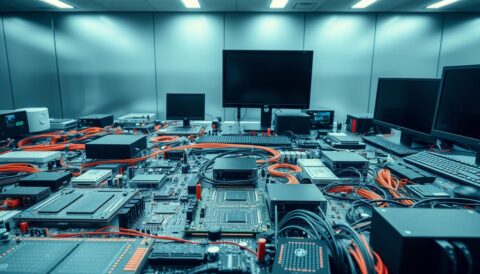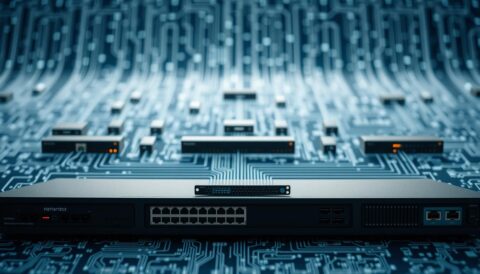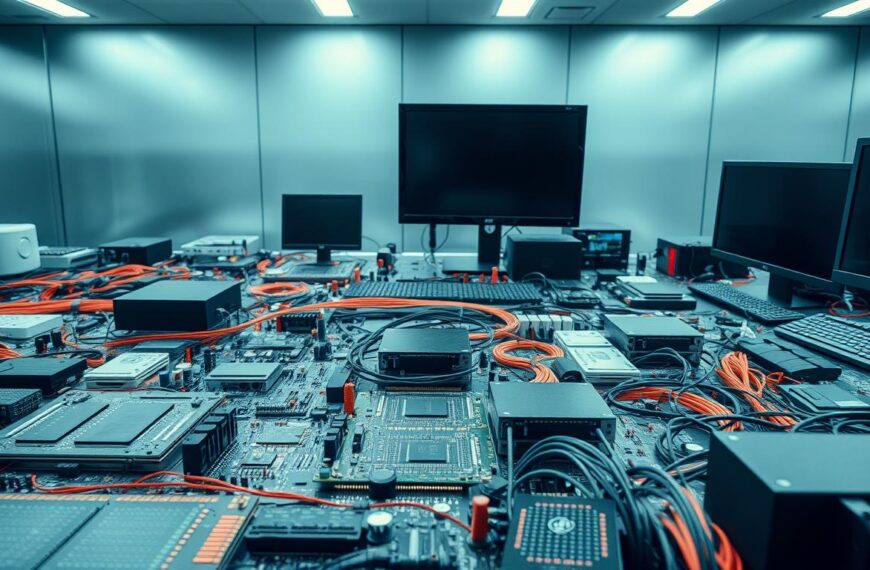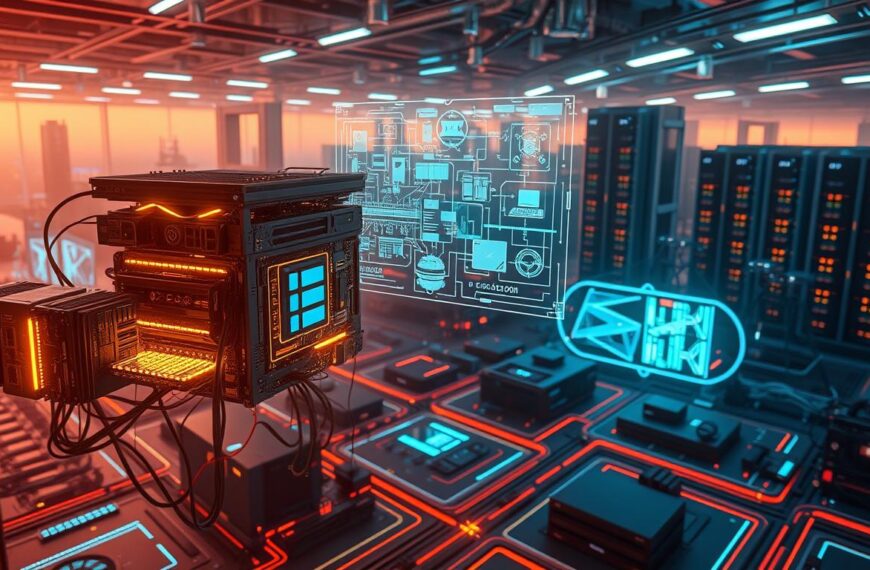Information technology is a fast-changing digital world. It helps companies turn data into valuable assets. Today’s computer tech includes advanced systems for handling and sharing information worldwide1.
These systems use hardware, software, and networks to boost company performance and creativity2.
The world of IT is always changing. IT experts manage key tech that keeps businesses running2. Companies use IT to automate tasks, get useful insights, and stay ahead of the competition3.
Now, IT goes beyond just computers. It includes cloud services, AI, and ways to connect people and systems.
Modern IT aims to make businesses more efficient. Some companies see a 30% boost in how they work thanks to good IT systems2. Digital tools help handle big data, leading to new ideas and better decisions3.
New trends in tech show how vital security is. Almost 40% of IT pros see digital safety as key2. The tech world is growing, offering great chances but also big challenges for all.
Understanding Information Technology: Core Concepts and Definitions
Information technology has changed a lot since it started. It has moved from simple computers to big digital systems that help businesses today4. This change shows how much technology has grown and changed.
The term “information technology” was first used by the Harvard Business Review in 19584. This was a big moment. It helped us understand the difference between special and general computers.
Evolution of IT Since the 1950s
IT has seen a lot of growth over the years:
- 1950s: Mainframe computing era
- 1970s: Personal computer revolution
- 1990s: Internet connectivity emergence
- 2000s: Cloud computing innovations
Key Components of Modern IT Systems
Today’s IT systems have important parts:
- Hardware devices
- Software applications
- Network infrastructure
- Data management systems
The Distinction Between Hardware and Software
IT parts work in different ways. Hardware is the physical stuff, like computers. Software is the instructions that make them work.
| Hardware | Software |
|---|---|
| Physical computing devices | Programmable instructions |
| Tangible components | Intangible digital instructions |
| Processors, memory, storage | Operating systems, applications |
“Technology is best when it brings people together.” – Matt Mullenweg
The IT job market is growing fast5. There are lots of chances for different jobs. People working in IT can have exciting careers and good pay4.
What is Information and Computer Technology?
Information technology (IT) is a fast-changing field. It deals with managing and processing digital information using advanced computer systems6. IT combines different areas like data handling, technical support, and communication. It also includes the tech solutions that run today’s businesses6.
The growth of computer technology is impressive. IT became a unique field in the 1990s. It changed how we use digital systems in work and life7. Today, IT covers important areas like:
- Network infrastructure
- Data management
- Cybersecurity
- Cloud computing
- Artificial intelligence
Almost every business relies on IT for better performance6. IT has made things more efficient. It gives us easier access to information and simplifies complex tasks6.
“Technology is best when it brings people together and creates meaningful connections.” – Matt Mullenweg
Today’s IT offers many advanced technologies. For example, social media uses machine learning, and healthcare and education use AI6. The need for skilled IT workers keeps growing. This shows how important tech is in our digital world6.
| IT Domain | Key Functions |
|---|---|
| Network Systems | Connectivity and Communication |
| Cybersecurity | Data Protection and Risk Management |
| Cloud Computing | Scalable Digital Infrastructure |
| Artificial Intelligence | Intelligent Automation and Analysis |
IT experts need a wide range of skills. They must be tech-savvy, good at solving problems, and able to communicate well. This helps them handle the complex world of computer technology6.
The Fundamental Components of IT Infrastructure
IT infrastructure is key to modern businesses, linking different tech parts for smooth operations. Knowing these parts is vital for companies wanting to boost their tech skills8.
The heart of IT infrastructure has several main parts that work together well. These are hardware, software, network systems, and data management solutions9.
Network Architecture and Systems
Network systems are the backbone of IT infrastructure. They help in sharing data, connecting, and keeping communication channels open8. Today’s network setups offer:
- Scalable communication platforms
- Robust data transmission capabilities
- Secure interconnectivity between systems
Data Storage and Management Solutions
Data management is crucial in today’s IT world. Companies use advanced storage solutions for:
- Efficient data collection
- Secure information preservation
- Streamlined access mechanisms
Cloud and hybrid options have changed data management, making it flexible and affordable10.
Security Frameworks and Protocols
Strong security is essential to protect digital assets. Companies with good security frameworks can lower breach risks10.
“A well-designed IT infrastructure is the foundation of digital resilience and operational excellence.”
| Infrastructure Component | Key Function | Performance Impact |
|---|---|---|
| Network Systems | Communication | Enhanced Connectivity |
| Data Storage | Information Management | Efficient Data Handling |
| Security Protocols | Risk Mitigation | Breach Prevention |
Effective IT infrastructure integration ensures organisations remain competitive, adaptable, and technologically prepared for future challenges8.
The Role of IT in Modern Business Operations
Information technology is now key to how businesses work and compete online11. Digital transformation is essential for staying ahead in the market12.
Business technology helps companies work more efficiently and productively. IT systems are vital for many business tasks:
- Streamlining communication across global teams
- Automating complex business processes
- Enabling data-driven decision-making
- Enhancing customer relationship management
“Technology is best when it brings people together and creates opportunities for collaboration and innovation.” – Matt Mullenweg
IT jobs are growing fast, with a 35% increase in information security analysis jobs by 203111. Companies use advanced IT to handle big data and complex tasks11.
Important trends in IT include:
- Cloud computing services
- AI and machine learning applications
- Advanced cybersecurity frameworks
- Real-time data analytics
IT careers are diverse, found in many sectors like healthcare and manufacturing13. Businesses that use IT well gain a big edge, driving innovation and excellence11.
Essential Types of Information Technology Systems
Information technology systems are key in today’s world. They help make businesses more efficient and innovative. Digital transformation strategies are changing how companies work14.
Companies use many different systems to get better at what they do. These range from basic tools to complex analytical tools15.
Cloud Computing Platforms
Cloud computing has changed how businesses handle data. About 70% of companies use cloud solutions to work better and save money14. These platforms are flexible and grow with modern business needs.
- Enables remote data access
- Provides cost-effective storage solutions
- Supports collaborative work environments
Database Management Systems
Database systems are vital for managing and finding information quickly. They are the heart of making decisions based on data16. Examples include systems for sales, inventory, and human resources.
Effective database management turns raw data into useful insights.
Artificial Intelligence and Machine Learning Technologies
AI in IT is growing fast, with a market expected to hit over £190 billion by 202514. These technologies help with complex data analysis, automation, and smart decision-making in many fields.
- Predictive analytics
- Automated customer service
- Advanced data processing
By using these key IT systems, companies can see big improvements in how they work, what they produce, and their overall strategy15.
Information Technology Administration and Management
IT management is key in today’s organisations. It drives tech strategy and ensures things run smoothly. Tech leaders are vital in making businesses better with new tech17.

The IT world is always changing. Jobs in computer and IT tech are set to grow 15% by 2031. This shows how fast the field is moving17. Leaders must tackle big challenges, keep systems strong, and bring in new ideas.
- Strategic technology planning
- Infrastructure management
- Team leadership and development
- Cybersecurity implementation
Today’s IT work is very detailed. About 94% of companies use cloud services for data. This shows how important good tech systems are17.
| Key IT Management Metrics | Current Performance |
|---|---|
| Cloud Service Adoption | 94% |
| Productivity Increase | 20-30% |
| Average IT Manager Salary | £146,000 |
“Effective IT management transforms technological challenges into strategic opportunities.” – Tech Leadership Insights
Good IT managers see tech as a way to change businesses. With 79% of companies seeing big improvements from IT automation17, the need for tech leaders is greater than ever.
The Impact of IT on Communication and Collaboration
Digital communication has changed how companies talk and work together. Information technology helps teams across the world work smoothly. This has changed how teams collaborate18.
Remote work tools have changed the game in how teams work. They help businesses create flexible work spaces. Companies using these tools see big benefits:
- Teams work better, up to 30% more productive18
- Projects finish faster, 25% quicker18
- Employees are happier and have better work-life balance18
Digital Workplace Solutions
Modern tech breaks down old communication barriers. It makes teams work faster, cutting project times by 40%18.
| Collaboration Tool | Productivity Impact |
|---|---|
| Video Conferencing | Reduces communication delays |
| Project Management Software | Improves team coordination |
| Cloud-based Sharing Platforms | Enables global team collaboration |
Remote Work Technologies
Remote work tech has changed how we work. Tools for cross-functional teams make projects 35% faster. This makes teams more efficient and adaptable18.
Digital communication is no longer a luxury, but a fundamental necessity for modern businesses.
By using these tools, companies can create better work places. Places that are more responsive, innovative, and connected. They go beyond old limits.
Cybersecurity in Information Technology
Cybersecurity is now a key part of IT security in our digital world. Companies face more cyber threats than ever before. They need strong protection plans to keep their data safe19.
Cyber threats are a big problem for businesses all over the world. Ransomware attacks have gone up by 300% in recent years20. The world’s economy loses USD 10.5 trillion each year to cybercrime by 202519.
- Protect sensitive information from unauthorized access
- Implement robust security protocols
- Train employees in cybersecurity best practices
IT security is very important. Almost 63% of companies have had a data breach in the last year. Human mistakes cause about 93% of these breaches20. This shows how vital good cybersecurity plans are.
“Cybersecurity is no longer an option, but a necessity for modern organisations.”
Companies are spending a lot on cybersecurity. They plan to spend over USD 1.75 trillion on it from 2021 to 202519. The job market for cybersecurity experts is also growing fast, with a 32% increase expected by 203219.
| Cybersecurity Metric | Current Status |
|---|---|
| Average Cost of Data Breach | USD 4.88 million |
| Organisations Experiencing Breaches | 63% |
Good cybersecurity strategies include using advanced threat detection, doing regular security checks, and training employees well. Proactive defence is always better than reactive measures.
Innovation and Future Trends in IT
The world of IT is changing fast, changing how we use technology. Digital transformation is now key for businesses to stay ahead. It’s not just a trend, it’s essential21.
New technologies are bringing big changes to many areas. Companies are using these new tools to change how they work and improve efficiency22:
- Generative AI is being used in work processes22
- Quantum computing is getting better22
- 5G networks are growing fast21
Key Future Tech Trends
The digital world is seeing huge tech leaps. By 2025, 50 billion devices will be connected through the Industrial Internet of Things (IIoT). This shows how big the future of connected tech is21.
| Technology | Market Projection | Impact |
|---|---|---|
| Quantum Computing | $65 billion by 202722 | Advanced problem-solving |
| 5G Technology | $667 billion by 202622 | Enhanced connectivity |
| IoT Market | $1.1 trillion by 202622 | Smart infrastructure |
“We can expect more technological progress in the next decade than in the last 100 years combined.” – Peter Diamandis21
With IT changing so fast, companies need to stay quick and keep learning. They must use these new technologies well to grow.
IT Skills and Professional Development

The world of IT skills is changing fast. It’s vital for professionals to keep up with new tech. Tech professional development is key for success in the fast-paced IT world23.
Now, IT education must cover both technical skills and soft skills. This balance is essential.
IT professionals should focus on:
- Programming Languages: Python, JavaScript, and Java are in high demand24
- Cloud Computing Technologies
- Cybersecurity Expertise
- Data Analytics
IT salaries vary a lot depending on the role. Roles in technology infrastructure management can earn between £86,000 and £195,000 a year25. The best IT pros know that learning never stops.
“Up to 90% of IT professionals believe that learning new skills is vital for career growth”24
Good communication skills are just as important as technical skills. 87% of hiring managers say that being able to work well with others is as important as being tech-savvy24. IT pros need to be good at both to succeed today.
The IT sector is set to grow a lot, with a predicted increase of £1.4 trillion by 202324. This growth means lots of chances for those who keep learning and adapting.
Business Applications and Software Solutions
Enterprise software has changed how businesses work today. Modern companies use advanced business apps to make their workflows smoother and grow strategically26. These IT solutions are key to boosting productivity and staying ahead in the market27.
The world of business apps includes several main types:
- Customer Relationship Management (CRM) systems
- Enterprise Resource Planning (ERP) platforms
- Business Intelligence (BI) tools
- Marketing automation platforms
Using these technologies can lead to big improvements. CRM software can increase sales by up to 34%, and marketing automation can raise conversion rates by 53%26. Information technology keeps changing how businesses work with new software.
“Digital transformation is no longer optional—it’s a strategic imperative for business survival.” – Tech Industry Expert
The global market for business apps is expected to hit $1 trillion by 202626. This shows how vital technology is for making businesses more efficient. About 90% of workers say automation tools make them more productive26.
Modern business apps offer many benefits:
- Automated workflow processes
- Enhanced decision-making capabilities
- Improved customer engagement
- Cost reduction strategies
Cloud-based solutions have also changed enterprise software, making it more flexible and scalable. Around 80% of companies are happy with cloud technologies26.
Information Technology Compliance and Governance
Today, navigating IT compliance and governance is key for businesses. They must create strong plans to handle tech risks and follow rules28.
IT governance frameworks are vital. They link tech plans with business goals. These frameworks help manage big IT investments, use resources well, and cut down risks28.
Regulatory Requirements in IT
Businesses must meet many data protection laws and industry rules. The main challenges are:
- Keeping organisational data safe
- Following rules
- Handling data across borders
Data Protection Standards
It’s crucial to have strong data protection standards for IT compliance. Important steps include:
- Writing down IT policies and steps
- Setting up clear governance frameworks29
- Doing regular risk checks30
Standards like ISO 38500 guide IT governance worldwide29. Companies with good IT governance can cut IT risks by up to 40%28.
| Compliance Area | Key Focus | Potential Impact |
|---|---|---|
| GDPR | Data Protection | Improved Privacy |
| HIPAA | Healthcare Data | Secure Patient Info |
| ISO Standards | Governance Framework | Better Operations |
Good IT governance is more than following rules. It’s about wisely managing tech resources.
The IT governance market is growing fast. It’s expected to jump from $30.5 billion in 2023 to $50 billion by 202830. This shows how vital strong IT compliance and governance are today.
Conclusion
Information technology is changing our world fast, bringing new ideas to many areas. Machines are getting smarter, doing things we thought only humans could do31. This change is making jobs different, with new chances and some tasks being automated31.
The role of IT is growing as technology gets better. New tech could make healthcare and products safer, and help the economy31. Jobs in computer science are in demand, with salaries ranging from £50,500 to £137,500 a year32.
But, there are big challenges too. These include how tech affects learning, privacy, and our way of life31. We all need to keep learning and using new tech to stay ahead.
Looking ahead, AI, robotics, and IT will keep changing what’s possible. This is just the start of a journey that will change how we work, talk, and see our potential.
FAQ
What exactly is Information and Computer Technology (IT)?
IT is a wide field that includes computer systems, software, and networks. It’s about managing digital information in both work and personal settings.
How has Information Technology evolved over the past decades?
IT has changed a lot since the 1950s. It moved from big computers to personal devices and cloud computing. Now, we have new tech like AI and the Internet of Things.
What are the primary components of an IT system?
IT systems have hardware, software, networks, databases, and security. Hardware are the devices, software are the programs, networks help us communicate, databases store data, and security keeps it safe.
Why is IT crucial for modern businesses?
IT helps businesses talk better, work faster, and make smart choices. It also helps them work together globally and manage customer relationships well.
What career opportunities exist in Information Technology?
IT has many jobs like network admin, cybersecurity expert, software developer, and data analyst. There are also roles in cloud computing, AI, and IT management in different fields.
How important is cybersecurity in modern IT?
Cybersecurity is key to keep businesses safe from online threats. It stops data breaches and keeps customers trusting. It uses tech and people skills to protect.
What emerging technologies are shaping the future of IT?
New tech like quantum computing, edge computing, AI, and IoT are changing IT. They’re making how we use digital systems better.
How can professionals stay updated in the rapidly changing IT landscape?
To keep up, professionals should learn constantly, get certifications, and take online courses. Going to tech events and joining networks also helps.
What are the key compliance considerations in Information Technology?
Important compliance includes following data protection laws like GDPR and keeping to industry standards. It’s also about using tech ethically and managing data well.
How does cloud computing impact modern IT infrastructure?
Cloud computing offers flexible and affordable ways to store data and run software. It helps businesses save money and work more efficiently.
Source Links
- Definition of Information Technology | North Dakota Information Technology
- Information Systems vs. Information Technology: What to Know
- What is ICT (Information and Communications Technology)? | Definition from TechTarget
- What is IT? Understanding Information Technology Today
- What is Information Technology (IT)? | Basics of IT | NinjaOne
- What Is Computer Information Technology?
- What is information technology? | Definition from TechTarget
- What is IT infrastructure?
- 7 Components of IT Infrastructure: Definitions & Functions
- The Backbone of Modern Enterprises: 7 Components of IT Infrastructure Management
- What Is Information Technology? A Beginner’s Guide to the World of IT
- Digital Information Technology
- What is Information Technology | Info on IT Careers and Certs | CompTIA
- What is Information Technology? Types, Services, Benefits | upGrad blog
- 6 Main Types of Information Systems Used in Businesses
- 5 Types of Information Systems
- What is Information Technology? 2025 Guide
- The Power of Collaboration in Computer Technology
- What Is Cybersecurity? | IBM
- Cybersecurity or Information Technology: What’s the Difference? | Institute of Data
- Tech at the edge: Trends reshaping the future of IT and business
- 25 New Technology Trends for 2025 | Emerging Technologies 2025
- Information and Communication Technologies – General Information (CA Dept of Education)
- Top 5 Essential IT Skills For Beginners: Building A Strong Foundation For A Successful Career – MyComputerCareer
- EDUCAUSE Professional Pathways – The Information Technology Pathway
- Domo Resource – What are business apps and what benefits do they offer?
- What Is Business Technology? Unveiling Modern Solutions for Enterprises – C&C Technology Group
- What Is IT Governance? Why It Matters and How EA Supports It | ARdoq
- What is IT Governance? Definition & Best Practices
- Understanding the Key Differences Between IT Governance & Compliance
- 7 Conclusion | Information Technology and the U.S. Workforce: Where Are We and Where Do We Go from Here?
- Computer Science vs. Information Technology: Choose Your Path



